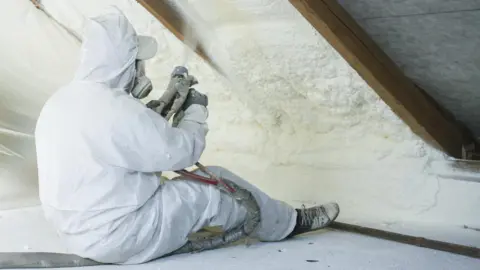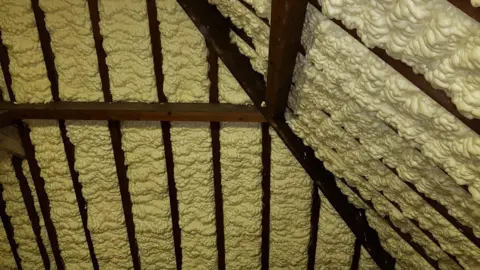 Getty Images
Getty ImagesHomeowners are struggling to sell or remortgage as some major lenders are rejecting properties with spray foam insulation, the BBC has found.
A quarter of the UK’s biggest mortgage providers will not lend against homes with spray foam in the roof, our research suggests.
It is estimated as many as 250,000 homes in the UK have this type of insulation, with much of it fitted under the previous government’s Green Homes Grant scheme.
“We were blissfully unaware of any issues to do with it until we put the house on the market,” said Wendy Rowe, whose family struggled to sell her late father’s home and paid thousands to have the insulation removed.
Some mortgage firms are reluctant to deal with homes with spray foam insulation due to concerns over poor fitting leaving moisture trapped and roof timbers at risk of decay.
But the Insulation Manufacturers Association said spray foam can be beneficial if properly installed, and it was worried homeowners could be needlessly driven to “cowboy” removals companies.
Ms Rowe told the BBC that when her father Alan Chawner was offered spray foam insulation in his loft, he thought it would make his ex-council property in Leicester warmer and cut his energy bills.
As a pensioner who claimed the attendance allowance, the entire £4,331 cost of the installation was covered by the Green Homes Grant scheme, which ran in England until 31 March 2021.
‘Left high and dry’
However, the work was not up to scratch, according to a report by Stephen Hodgson, the former boss of the Property Care Association (PCA) who now inspects properties with spray foam and trains surveyors.
After sales stalled and difficult conversations with lenders, Ms Rowe agreed to replace the roof entirely, splitting the cost of nearly £10,000 with new buyers.
She said it has cost the family thousands more in surveyors’ and estate agent fees and utility bills.
The firm that installed the spray foam, SealSixty, gave the family £400 as a gesture of goodwill and said the work met all the requirements set out by the Green Homes Grant scheme at the time.
Ms Rowe said that her family had been “left high and dry”.
“It was installed under a government initiative, and you really don’t expect them to turn their back,” she said.
What is spray foam insulation?
Spray foam insulation has been used to stop heat escaping from roofs, lofts and attics for decades and comes in two forms.
Closed cell spray foam is rigid once set. It is a better thermal insulator and was previously sold to stabilise failing roofs. But if it has been used inappropriately or installed poorly, it might put stress on timbers, restrict air circulation and put them at risk of decaying.
Open cell spray foam remains soft once set and is only used for insulation. It is more breathable but is often installed where a highly-resistant underlay like bitumen felt is already present, stopping vapour from escaping.
While a recent report by the Health and Safety Executive highlighted situations where using open cell was low-risk, it cautioned against applying it directly to roof tiles.
The nature of spray foam can make it tricky for valuers acting on behalf of lenders to inspect the condition of roof timbers.
When the BBC contacted the 20 largest lenders in the UK, five – including TSB Bank, Skipton Building Society, Co-operative Bank, Principality and equity release lender Aviva – said they did not lend against properties where spray foam is found in the roof space.
The Yorkshire Building Society and Metro Bank said they would not usually lend where there is a significant amount of spray foam.
Equity release provider More 2 Life told the BBC it will only lend on properties with spray foam where it was fitted as part of an authorised new build and has the necessary documentation.
Other lenders such as Lloyds, Nationwide, Barclays, the NatWest Group and Santander have said they consider applications on a case-by-case basis, and will take a valuer’s report into account.
They may, however, ask homeowners for documentation showing it has been installed correctly or for a specialist report to be carried out.
In 2023, the PCA published an inspection protocol in a bid to help surveyors and lenders assess any potential risk in pitched roofs.
 Wendy Rowe
Wendy RoweBut homeowners like Gary Wright feel like they have been “left in limbo”.
When his two-year fixed-rate mortgage was up for renewal, he hoped to find a better rate.
But when he applied he was shocked to discover open cell spray foam had been installed in 2009. It had not come up during surveys when he had bought the house.
He decided to remove most of the foam in the loft himself, after receiving several expensive quotes.
A surveyor still recommended a full roof report and Mr Wright felt he had to renew his mortgage with his current lender at a less preferable rate.
“We know that in the next two years, we need to get this fixed, and I can’t afford to right now,” he said.
“This phrase ‘spray foam’ has created fear [among lenders] based on a lack of knowledge,” Simon Storer, chief executive of the Insulation Manufacturers Association, told the BBC.
He suggested “hares were set running” by previous industry guidance that has since been withdrawn.
“Insulating is a very good thing,” he said, adding: “But as with any building work, it needs to be done correctly”.
He said the organisation was also concerned about unregulated companies targeting older, potentially vulnerable, homeowners pushing them to pay for an overpriced removal service during cold calls.
The Homeowners Alliance (HOA) does not recommend installing spray foam until issues with lenders and rogue traders are resolved.

Advice for homeowners
For homes where it is already present, the HOA recommends:
- Checking you have all the relevant documentation, including a product certificate, installer warranty, before and after photos, a survey report and a product warranty
- Contacting the installer or manufacturer to see if you can get a free “health check”
- Considering an independent assessment by a qualified spray foam surveyor
A government spokesperson said it had “consulted lenders about this matter who say they rely on the views of valuers and surveyors on this issue”.
They added any measures fitted under government schemes must be done by a Trustmark-registered installer “to the highest standards with issues promptly and properly rectified”.
Further information on Trustmark’s dispute resolution process can be found here.





